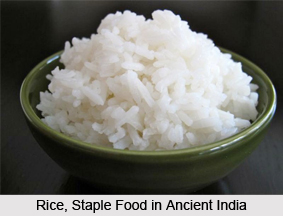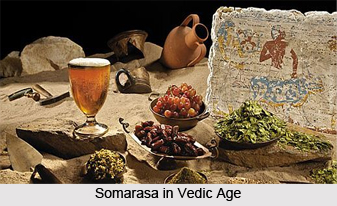 Food in Ancient India basically reflects the cultural evolution of Indian civilization from ancient past. Early Indians ate food that was easily available from nature. Fruits, wild berries, meat, fish, etc. were the main food items of the nomadic dwellers. With the advent of civilization, people settled and started to do farming. This led to the discovery of food crops, pulses, etc. Food in ancient India was cultivated in the fertile river valleys. Rice was their staple food that was eaten with cooked lentils, vegetables and meat.
Food in Ancient India basically reflects the cultural evolution of Indian civilization from ancient past. Early Indians ate food that was easily available from nature. Fruits, wild berries, meat, fish, etc. were the main food items of the nomadic dwellers. With the advent of civilization, people settled and started to do farming. This led to the discovery of food crops, pulses, etc. Food in ancient India was cultivated in the fertile river valleys. Rice was their staple food that was eaten with cooked lentils, vegetables and meat.Wheat was used to make flat breads known as "Chapati". The food habits of nearby countries also affected the food in ancient India. Cooking of chicken came to India from Thailand and mutton came from West Asia. The food pattern did not change with the arrival of the Aryans. With complex religious rituals taking the center stage, animal sacrifices peaked and more and more people turned vegetarians.
Milk and milk products came much into use during ancient times. Rice was eaten with curd. Cows were respected and worshipped hence people stopped eating beef. Most people in India became vegetarians and meat was consumed very rarely. Many spices were cultivated in India and were used in cooking for aroma and flavour. India flourished in the cultivation of spices and many of them were later exported to foreign lands.
Food in Ancient India can be divided into various ages that include food in Indus Valley civilisation, food in Vedic period, Food in Maurya period, food in Gupta period, food in post Gupta period which marked some difference with the advent of the Gujjars and Hunas. With the migration of outsiders in India changes were found within the food habits of India.

Food in Evolution of Indian Civilisation
Food in Ancient India developed considerably within the Indus Valley Civilisation which brought the use of wheat, barley, sesamum and brassica. Along with this, man had learned to tame buffaloes, goats and sheep which became useful for cultivation. Slowly and gradually this period marked the progress of man more towards civilized world with more scientific lifestyle.
The earliest Indians, the Harappans, probably ate mainly wheat and rice and chickpeas and lentils, and occasionally cows, pigs, sheep, goats and chicken. Indian cooks used many Central Asian herbs and spices - cinnamon, cumin, coriander, anise and fennel. Some of the wheat was made into stews or soups, and some into flat breads called ‘chapatis’ or yeast breads called ‘naan’. Indian people also enjoyed chewing on sugar cane, which grew naturally in India.
For more visit the link below: